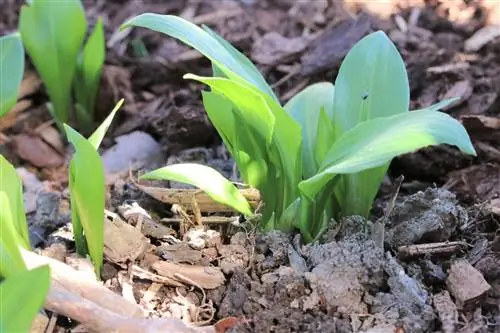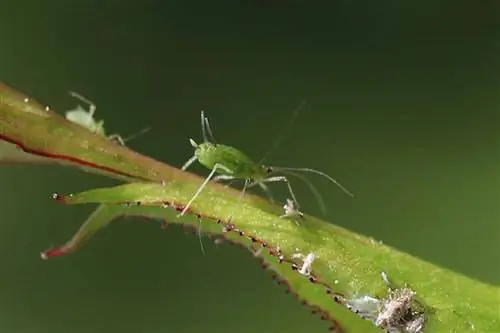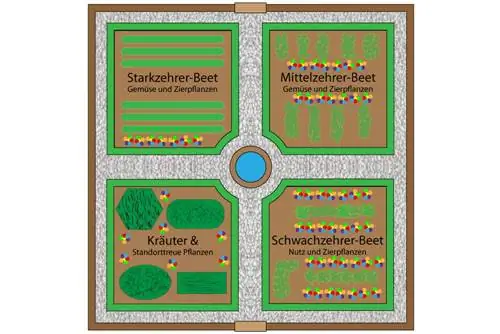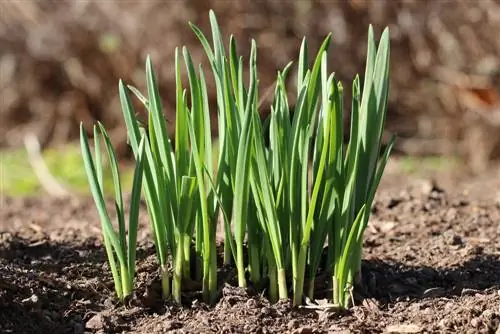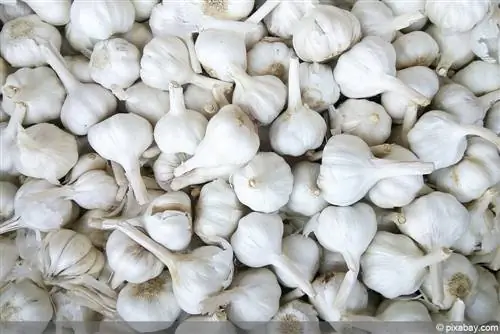- Author admin [email protected].
- Public 2023-12-17 03:39.
- Last modified 2025-01-24 12:45.
Wild garlic contains many good ingredients, in addition to having he alth-promoting effects on many individual areas of the body, it is said to generally strengthen the body. That's where it gets its name: The Germanic peoples were convinced that brown bears like to eat wild garlic after hibernation because it quickly helps them regain their bear strength.
In the kitchen it can be used in a variety of ways like garlic, but with wild garlic you are spared from unpleasant fumes. For fans of Mediterranean cuisine, this reason alone is enough to plan large areas of wild garlic in their garden, which can quickly become a reality if you keep a few things in mind:
Select location
Before you think about how to bring wild garlic into your garden, you should explore whether you can offer it a favorable location. Because wild garlic definitely needs a partially or fully shady place, it looks particularly good under bushes, trees and hedges. There it should encounter humus-rich, moist soil with as much lime as possible; the wild garlic will have a hard time in pure sandy soil.
Actually, wild garlic is not a plant for a very neatly designed garden, because it thrives in rotten leaves that have fallen from the plants above it. If you don't have such areas, you could bring in leaves from outside. The garden will then look a little more natural. You should plan a lot of space for the wild garlic. Once it feels comfortable, it will grow vigorously over the years.
If you don't want the wild garlic to spread all over the garden, you should even plan a rhizome barrier (root protection fleece) before you start planting.
Grow wild garlic
The choice is yours: wild garlic can be sown in the garden, planted as a bulb or planted as a finished plant. However, sowing is a rather tedious task because wild garlic seeds are cold germinators and take one to over two years to germinate. Even if you purchase pre-treated seeds commercially, you should be prepared for a fairly long germination time. And then it can also happen that the seeds were not fresh enough. Then perhaps they have already lost their ability to germinate? This happens quite quickly with wild garlic seeds.
If you want to plant wild garlic seeds, it is best to sow them straight away at the intended location. This can be in summer or autumn, then you can just wait and see if the seeds develop. The usual method of growing in small plant pots is theoretically conceivable, but you would then have to make sure that the plant pots are moist enough for up to two years, and it is also not entirely unlikely that a layer of moss will form on the plant pots during this time, which disrupts the germination of wild garlic seeds.
The wild garlic bulbs are simply stuck into the ground like a normal flower bulb. The top should be covered with soil by about one to two centimeters. You can plant the bulbs in groups of around four; the individual groups should be planted at a distance of around 30 cm from one another. The bulbs can be planted in the ground immediately throughout the delivery period, and in fact must be planted immediately as they cannot be stored. They should then sprout the following spring.
Insert finished plants
Depending on the weather, you can purchase wild garlic at this address between mid-February and the end of March. Here you get wild garlic plants that come fresh from the forest, they still have their leaves and will have grown in a few days after planting and watering.
The bulb should be placed a few centimeters below the surface of the soil when planting, the plants are planted about a hand's length apart. Don’t forget to water the wild garlic plants thoroughly after planting them out. You should also make sure that the soil does not dry out in the next two weeks. When the wild garlic has grown firmly, it becomes less demanding, but overall wild garlic prefers it moist rather than too dry.
Joyful self-sowing can become a nuisance
If your wild garlic feels comfortable, they will now spend a few problem-free years together, but then he will have the idea to reproduce. Once it's really started, it will spread uncontrollably if you don't set limits on it. Because wild garlic has two propagation strategies, it reproduces through bulb runners and through seeds that hard-working ants spread for it.
The fact that a rhizome barrier can be introduced to prevent the spread of onion runners has already been mentioned above. If you didn't put these around your wild garlic meadow from the start, now it's time to dig and insert root protection fleece. You can slow down the spread of seeds more easily: you just have to cut off the fruits before the seeds are ripe. The stems with the ball of small green balls at the end can be used for extravagant floral works of art, but you can also pickle the fruits like capers.

